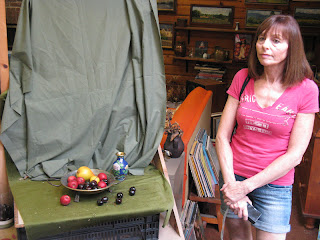I try to paint every day. If I don't get to the easel I read about art, visit galleries, or prepare canvases if I can. My routine is to paint landscapes and townscapes from life en plein air twice a week or more. I do still life on Thursday. In the studio I finish pieces not finished on site and do larger pieces from sketches and reference. If I stay in the studio I get antsy and stale. Even a walk helps that.
Recently I have been thrust into renovations. A good one for the book of excuses.
My Studio In the Background, A Plastic Blanket
It has been 10 days now. Supervision. No painting. It will go on for at least 4 more days.
In the past when I have taken a long break I found that getting back to it was not easy. First of all, other things took over my priorities. No concentration. Worse though is what you seem to lose. Just like an athlete who skips training, you lose fitness. The first thing that goes for me is the feel of the paint on the brush. That is big for me because it is all about paint manipulation. Then I lose some sharpness in seeing, and finally my sensitivity to value and simplification tail off. What to do.
My strategy often starts with preparing a set of canvases and panels first thing in the morning. That gets me wielding a brush and a knife. Then I call a friend and set up a painting date. Once on site I practice squinting for simplification and seeing values and edges. Then I compose something of interest in thumbnail form using the pencil as a brush and identifying 3 or 4 values on big masses - no detail. Finally I paint using a large brush and employing thin oil washes to emulate the thumbnail, massing in the shapes, while looking and squinting repeatedly at the scene and the centre of interest. On top of the thin washes I try to at least get to indicating the centre of interest with some pieces of paint that are at or near the finished state. This process seems to get me back on track when repeated a few times so the priorities are sorted out.
Sentinel, In Process













